Potrebujeme váš súhlas na využitie jednotlivých dát, aby sa vám okrem iného mohli ukazovať informácie týkajúce sa vašich záujmov. Súhlas udelíte kliknutím na tlačidlo „OK“.
ASTM D378-10
Standard Test Methods for Rubber (Elastomeric) Conveyor Belting, Flat Type
Automaticky preložený názov:
Štandardné skúšobné metódy pre Rubber (pružnú) dopravníkové pásy a remene, Flat typ
NORMA vydaná dňa 1.10.2010
Informácie o norme:
Označenie normy: ASTM D378-10
Poznámka: NEPLATNÁ
Dátum vydania normy: 1.10.2010
Kód tovaru: NS-24844
Počet strán: 13
Približná hmotnosť: 39 g (0.09 libier)
Krajina: Americká technická norma
Kategória: Technické normy ASTM
Kategórie - podobné normy:
Anotácia textu normy ASTM D378-10 :
Keywords:
belting, elastomeric, RMA, rubber, Breaking strength/tenacity--rubber, Burning characteristics--rubber/cellular materials, Carcass tear test, Conveyor belts, Elastomeric rubber materials, Fire testing--rubber/cellular materials, Flammability--rubber, Flat conveyor belting, Rubber belting, Rubber-/plastic-coated fabric, Troughability, ICS Number Code 83.060 (Rubber)
Doplňujúce informácie
| Significance and Use | ||||||||||||||||||||||||||||
|
Flat conveyor belts are used in many industrial applications in which they are subjected to a great variety of stresses and conditions. Service conditions can be calculated or measured. Design levels and test requirements are established by manufacturers, or end-users, or both. The tests (test methods) are used to measure the characteristics of conveyor belting as they relate to service conditions. The tests outlined by these test methods are commonly applied by belt manufacturers to control the quality of their products. Research and product development activities in flat belting involve extensive testing as outlined by these test methods. In case of conflict between the provisions of these test methods and those of detailed specifications or test methods for a particular belt, the latter shall take precedence. In case of conflict between the provisions of these test methods and those of detailed specifications or test methods for a particular belt, the latter shall take precedence. |
||||||||||||||||||||||||||||
| 1. Scope | ||||||||||||||||||||||||||||
|
1.1 These test methods (and references) cover the procedures for evaluating the physical properties of flat conveyor belting. Performance criteria for belting will not be detailed here, but can be found through the RMA (Rubber Manufacturers Association) Conveyor and Elevator Belt Handbook, ANSI (American National Standards Institute), various governmental authorities, and the International Organization for Standardization (ISO). Belting for conveying and elevating materials generally is designated and defined as follows: 1.1.1 Heavy Duty Conveyor—A heavy duty belt is defined as belting designed for bulk haulage of materials, such as stone, crushed rock, sand, metals ores, coal, wood chips, etc., and has a carcass strength (design) substantial enough to withstand conveyor system tensions of 160 PIW (pounds per inch of width) and above. 1.1.2 Light Duty Conveyor—A light duty belt is defined as belting designed for conveying a variety of lower weight (density) materials, packages, industrial and electronic goods, and food products. These belts often are shorter in length and width, with less overall thickness than heavy duty belting, and are generally used in conveyor systems with tensions less than 160 PIW. 1.1.3 General Description—Belting can have elastomeric coverings on one side, both sides, or neither side depending upon the specific application requirements. Belt coverings are comprised of various synthetic or natural rubber polymers, PVC, or other elastomeric materials, dependent upon application or customer requirements. The strength (load bearing) member(s) of most belting generally is a woven or interwoven carcass of synthetic or natural fibers, such as, but not limited to, polyester, nylon, polyaramide and cotton, as well as steel (cable/cord type or woven mesh). 1.2 This standard does not purport to address all of the application specific testing available or safety concerns, if any, associated with its use. It is the responsibility of the user of this standard to establish appropriate safety and health practices and determine the applicability of regulatory limitations prior to use. |
||||||||||||||||||||||||||||
| 2. Referenced Documents | ||||||||||||||||||||||||||||
|
Podobné normy:
Historická
1.6.2010
Historická
1.11.2013
Historická
1.5.2010
Historická
1.5.2014
Historická
1.5.2012
Historická
1.9.2014


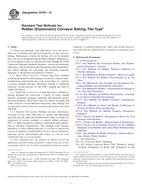
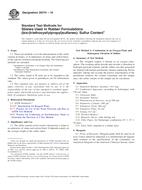 ASTM D6741-10
ASTM D6741-10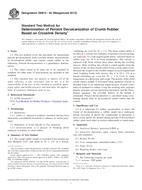 ASTM D6814-02(2013)..
ASTM D6814-02(2013)..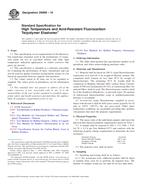 ASTM D6909-10
ASTM D6909-10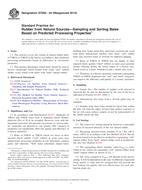 ASTM D7050-04(2014)..
ASTM D7050-04(2014)..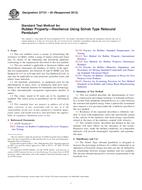 ASTM D7121-05(2012)..
ASTM D7121-05(2012).. ASTM D7427-14
ASTM D7427-14
 Cookies
Cookies
